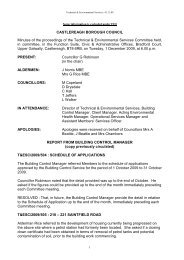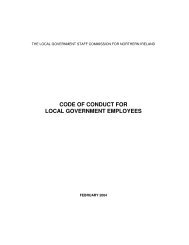MICE MICE - Carrickfergus Borough Council
MICE MICE - Carrickfergus Borough Council
MICE MICE - Carrickfergus Borough Council
You also want an ePaper? Increase the reach of your titles
YUMPU automatically turns print PDFs into web optimized ePapers that Google loves.
What are the signs of infestation?<br />
There are a number of signs to look out for and if found, may<br />
indicate mouse activity.<br />
Mice droppings<br />
Droppings are often black, rod shaped and 3-6mm long.<br />
Fresh droppings will be soft and moist. Each mouse can leave<br />
approximately 80 droppings per day. Common places to find<br />
mouse droppings are under the kitchen sink, around central<br />
heating boilers and in roof spaces.<br />
Smears<br />
These are dark grey marks left on surfaces by repeated contact<br />
with the oils in mouse fur.<br />
Nests<br />
Sometimes nests can be found indoors for example in lofts,<br />
under floorboards or in airing cupboards.<br />
Gnawing<br />
Mice gnaw continually on materials such as wood, carpets,<br />
paper, pipe cables and furniture. Check for damage to<br />
foodstuffs in cupboards.<br />
Why must mice be controlled?<br />
In addition to the damage caused through gnawing, mice have<br />
been known to spread diseases such as salmonella and listeria,<br />
which lead to food poisoning and stomach upsets.<br />
How can I prevent mouse infestation?<br />
Householders can assist in preventing mouse infestation by<br />
taking a number of simple precautions.<br />
- Do not leave household waste where mice can get access<br />
to it, close dustbin lids and composters and do not feed<br />
wild birds to excess - you may be feeding mice as well.<br />
How can I get rid of mice?<br />
It is important to get rid of mice quickly, as house mice<br />
reproduce rapidly. It is possible to carry this work out<br />
yourself however, a professional pest control expert<br />
will always have more technical expertise and access to<br />
rodenticides that are not available over the counter.<br />
If you decide to carry out the work yourself there are two<br />
options, – poison or break-back traps.<br />
Mouse poison (rodenticide) can be bought from most<br />
hardware stores and most garden centres. Put the poison in<br />
a safe and secure place out of reach of children and pets and<br />
ALWAYS wash your hands after use. Rodenticide can take<br />
4-12 days to take effect. This may result in a localised foul<br />
smell due to the presence of carcasses.<br />
Break-back traps may be set and these should be placed<br />
next to walls where mice tend to travel. The trap should be<br />
baited with chocolate, biscuit or cereal. Use several traps<br />
and examine them daily, removing dead mice as soon as<br />
they are discovered. All traps should be handled with care.<br />
Seek professional advice from the <strong>Council</strong>’s Environmental<br />
Health Service if you require any assistance.<br />
Warning: When using pesticides always follow the<br />
instructions on the label. Remember that pesticides may<br />
be harmful to other animals e.g. household pets etc.<br />
- Keep your home in good repair. Mice only need a gap the<br />
diameter of a pencil to gain entry.<br />
- Remove potential nesting sites by keeping yards and gardens<br />
clean and tidy, and by cutting back overgrown areas.<br />
- Seal gaps around heating and water pipes.<br />
- Ventilation bricks and slots should already have a fine wire<br />
mesh incorporated. If this is worn, replace it externally with<br />
3.15mm insect mesh.
















